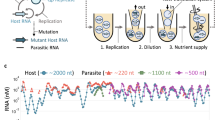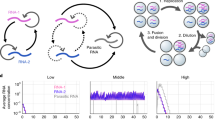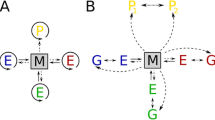Abstract
In the RNA world hypothesis, RNA(-like) self-replicators are suggested as the central player of prebiotic evolution. However, there is a serious problem in the evolution of complexity in such replicators, i.e., the problem of parasites. Parasites, which are replicated by catalytic replicators (catalysts), but do not replicate the others, can destroy a whole replicator system by exploitation. Recently, a theoretical study underlined complex formation between replicators—an often neglected but realistic process—as a stabilizing factor in a replicator system by demonstrating that complex formation can shift the viable range of diffusion intensity to higher values. In the current study, we extend the previous study of complex formation. Firstly, by investigating a well-mixed replicator system, we establish that complex formation gives parasites an implicit advantage over catalysts, which makes the system significantly more vulnerable to parasites. Secondly, by investigating a spatially extended replicator system, we show that the formation of traveling wave patterns plays a crucial role in the stability of the system against parasites, and that because of this the effect of complex formation is not straightforward; i.e., whether complex formation stabilizes or destabilizes the spatial system is a complex function of other parameters. We give a detailed analysis of the spatial system by considering the pattern dynamics of waves. Furthermore, we investigate the effect of deleterious mutations. Surprisingly, high mutation rates can weaken the exploitation of the catalyst by the parasite.

















Similar content being viewed by others
Notes
This problem is often referred to as the error threshold or information threshold, although the problem does not necessarily exhibit threshold-like behavior (Takeuchi and Hogeweg 2007).
In the genomic tag hypothesis, Maizels and Weiner (1998) suggested a tRNA-like structure as such a tag motif in ancient RNA genomes.
If it were used to obtain the dynamics of the replicators, θ would cancel out in the growth term κc xx θ, and thus there would be no limitation to the growth, which is not sensible. According to numerical solutions of Eq. (5), when κ \( \gg \) b i , c xx θ suddenly becomes zero at θ = 0 (i.e., x t + y t = 1) in a singular-like manner. This behavior cannot be captured if one takes the limit of κ i → ∞ (i = x, y) because the term κ i θ appears in Eq. (5).
E.g. for the replication reaction to happen, one cell must be empty, and the other must be a complex.
Strictly speaking, θ = 1−x−y−2c xx −2c xy in the CA model because a complex occupies twice as much space as a single molecule, but this hardly affects the results.
The template activity of parasites was 1% higher than that of the catalyst.
See also footnote 8.
R was set small in attempt to make β max comparable to that for R = 0. However, it turns out that a slight mutation can significantly increase β max when a parameter set allows the formation of wave patterns. An increase can be as much as 20% for D = 0.01. This increase of β max can be understood in the light of pattern dynamics of waves, which is developed later in this paper. Mutation inoculates a small number of parasites in the traveling front of waves (see Fig. 5, D = 0.1), and thereby, the parasite can split a wave in a few parts, giving rise to more waves. Thus, a slight mutation can enhance the stability of the system.
In a standard predator–prey (host–parasite) system predators (parasites) can directly kill preys (host), whereas in the current model, such a direct killing does not happen. To replace a catalyst population, parasites must wait until the catalysts disappear via intrinsic decay.
The following two sets of parameters were examined: (1) log10 D ∞ = −1.15 (D 2 ≈ 0.053), k 2 = 1, k 1 = 0.085, k −1 = 0.001, d = 0.00125; and (2) log10 D ∞ = −1.075 (D 2 ≈ 0.063), k 2 = 1, k 1 = 0.085, k −1 = 0.001, d = 0.015. See Füchslin et al. (2004) for the notation.
Note that M max is not exactly the same as the error threshold: while the error-threshold phenomenon—or the breakdown of Darwinian optimization—happens because of the competition between the fittest and the mutants (Eigen et al. 1989; see also Takeuchi and Hogeweg 2007), M max exists because X cannot grow faster than it decays for a sufficiently large M.
Suppose β = 1 is tolerable, and the next examined value β = 2 is not tolerable, but the third examined value β = 1.5 is tolerable. Then, it might be that β = 2 is tolerable if the initial condition is taken from the system with β = 1.5 instead from that with β = 1.
References
Allee WC (1931) Animal aggregations: a study in general sociology. University of Chicago Press, Chicago
Altmeyer S, Füchslin RM, McCaskil JS (2004) Folding stabilizes the evolution of catalysts. Artif Life 10:23–38
Bartel DP (1998) Re-creating an RNA replicase. In: Gesteland RF, Cech TR, Atkins JF (eds) The RNA world, 2nd ed. Cold Spring Harbor Laboratory Press, Cold Spring Harbor, pp. 143–162
Boerlijst MA, Hogeweg P (1991a) Selfstructuring and selection: spiral waves as a substrate for prebiotic evolution. In: Langton CG, Taylor C, Farmer JD, Rasmussen S (eds) Artificial Life II. Addison Wesley, Massachusetts, pp. 255–276
Boerlijst MC, Hogeweg P (1991b) Spiral wave structure in pre-biotic evolution: hypercycles stable against parasites. Physica D 48:17–28
Bresch C, Niesert V, Harnasch D (1980) Hypercycles, parasites and packages. J Theor Biol 85:399–405
Campos PRA, Fontanari JF, Stadler PF (2000) Error propagation in the hypercycle. Phys Rev E Stat Phys Plasmas Fluids Relat Interdiscip Topics 61:2996–3002
Cesh TR (1986) A model for the RNA-catalyzed replication of RNA. Proc Natl Acad Sci USA 83:4360–4363
Chen IA, Hanczyc MM, Sazani PL, Szostak JW (2006) Protocells: genetic polymers inside membrane vesicles. In: Gesteland RF, Cech TR, Atkins JF (eds) The RNA world, 3rd ed. Cold Spring Harbor Laboratory Press, Cold Spring Harbor, pp. 57–88
Crick FH (1968) The origin of the genetic code. J Mol Biol 38:367–379
De Boer RJ, Pagie L (2005) GRIND Ver 2.05. http://www.theory.bio.uu.nl/rdb/software.html
Eigen M (1971) Selforganization of matter and the evolution of biological macromolecules. Naturwissenschaften 58:465–523
Eigen M, Schuster P (1979) The hypercycle—a principle of natural selforganization. Springer–Verlag, Berlin
Eigen M, McCaskill J, Schuster P (1989) The molecular quasi-species. Adv Chem Phys 75:149–263
Füchslin RM, Altmeyer S, McCaskill JS (2004) Evolutionary stabilization of generous replicases by complex formation. Eur Phys J B 38:103–110
García-Tejedor A, Morán F, Montero F (1987) Influence of the hypercyclic organization on the error threshold. J Theor Biol 127:393–402
Gesteland RF, Cech TR, Atkins JF (eds) (2006) The RNA world, 3rd ed. Cold Spring Harbor Laboratory Press, Cold Spring Harbor
Gilbert W (1986) The RNA world. Nature 319:618
Gillespie DT (1976) A general method for numerically simulating the stochastic time evolution of coupled chemical reactions. J Comput Phys 22:403–434
Hanczyc MM, Dorit RL (1998) Experimental evolution of complexity: in vitro emergence of intermolecular ribozyme interactions. RNA 4:268–275
Hogeweg P, Takeuchi N (2003) Multilevel selection in models of prebiotic evolution: compartments and spatial self-organization. Orig Life Evol Biosph 33:375–403
Huynen MA, Hogeweg P (1994) Pattern generation in molecular evolution: exploitation of the variation in RNA landscapes. J Mol Evol 39:71–9
Johnston WK, Unrau PJ, Lawrence MS, Glasner ME, Bartel DP (2001) RNA-catalyzed RNA polymerization: accurate and general RNA-templated primer extension. Science 292:1319–1325
Joyce GF (1983) The instability of the autogen. J Mol Evol 19:192–194
Joyce GF (1987) Nonenzymatic template-directed synthesis of informational macromolecules. Cold Spring Harb Symp Quant Biol 52:41–51
Joyce GF (1998) Appendix 3: reactions catalyzed by RNA and DNA enzymes. In: Gesteland RF, Cech TR, Atkins JF (eds) The RNA world, 2nd ed. Cold Spring Harbor Laboratory Press, Cold Spring Harbor, pp. 687–690
Joyce GF, Orgel LE (2006) Progress toward understanding the origins of the RNA world. In: Gesteland RF, Cech TR, Atkins JF (eds) The RNA world, 3rd ed. Cold Spring Harbor Laboratory Press, Cold Spring Harbor, pp. 23–56
Joyce GF, Schwartz AW, Miller SL, Orgel LE (1987) The case for an ancestral genetic system involving simple analogues of the nucleotides. Proc Natl Acad Sci USA 84:4398–4402
Kaneko K, Ikegami T (1992) Homeochaos: dynamic stability of a symbiotic network with population dynamics and evolving mutation rates. Physica D 56:406–429
Károlyi G, Péntrek A, Scheuring I, Tél T, Toroczkail Z (2000) Chaotic flow: the physics of species coexistence. Proc Natl Acad Sci USA 97:13661–13665
Ke A, Doudna JA (2006) Catalytic strategies of self-cleaving ribozymes: relics of an RNA world. In: Gesteland RF, Cech TR, Atkins JF (eds) The RNA world, 3rd ed. Cold Spring Harbor Laboratory Press, Cold Spring Harbor, pp. 109–131
Kun Á, Santos M, Szathmáry E (2005) Real ribozymes suggest a relaxed error threshold. Nat Genet 37:1008–1011
Küppers B (1983) Molecular theory of evolution: outline of a physico-chemical theory of the origin of life. Springer–Verlag, Berlin
Kuznetsov YA (1999) CONTENT Ver 1.5. http://www.math.uu.nl/people/kuznet/CONTENT/
Lehman N (2003) A case for the extreme antiquity of recombination. J Mol Evol 56:770–777
Maizels N, Weiner AM (1998) The genomic tag hypothesis: what molecular fossils tell us about the evolution of tRNA. In: Gesteland RF, Cech TR, Atkins JF (eds) The RNA world, 2nd ed. Cold Spring Harbor Laboratory Press, Cold Spring Harbor, pp. 79–111
Maynard Smith J (1979) Hypercycles and the origin of life. Nature 280:445–446
McCaskill JS, Füchslin RM, Altmeyer S (2001) The stochastic evolution of catalysts in spatially resolved molecular systems. Biol Chem 382:1343–1363
Michod R (1983) Population biology of the first replicators: the origin of genotype, phenotype and organism. Am Zool 23:5–14
Muller HJ (1966) The gene material as the initiator and the organizing basis of life. Am Nat 100:493–517
Nuño JC, Andrade MA, Montero F (1993) Non-uniformities and superimposed competition in a model of an autocatalytic network formed by error-prone self-replicative species. Bull Math Biol 55:417–449
Orgel LE (2004) Prebiotic chemistry and the origins of the RNA world. Crit Rev Biochem Mol Biol 39:99–23
Orr HA (2000) The rate of adaptation in asexuals. Genetics 155:961–968
Pace NR, Marsh TL (1985) RNA catalysis and the origin of life. Orig Life 16:97–116
Pagie L, Hogeweg P (1999) Colicin diversity: a result of eco-evolutionary dynamics. J Theor Biol 196:251–261
Pagie L, Hogeweg P (2000) Individual-and population-based diversity in restriction modification systems. Bull Math Biol 62:759–774
Santos M, Zintzaras E, Szathmáry E (2004) Recombination in primeval genomes: a step forward but still a long leap from maintaining a sizable genome. J Mol Evol 59:507–519
Savill NJ, Rohani P, Hogeweg P (1997) Self-reinforcing spatial patterns enslave evolution in a host-parasitoid system. J Theor Biol 188:11–20
Scheuring I, Czárán T, Szabó P, Károlyi G, Toroczkai Z (2003) Spatial models of prebiotic evolution: soup before pizza? Orig Life Evol Biosph 33:319–355
Segel LA (1984) Modeling dynamic phenomena in molecular and cellular biology. Cambridge University Press, Cambridge
Segré D, Ben-Eli D, Lancet D (2000) Compositional genomes: prebiotic information transfer in mutually catalytic noncovalent assemblies. Proc Natl Acad Sci USA 97:4112–4117
Sharp PA (1985) On the origin of RNA splicing and introns. Cell 42:397–400
Stadler BMR, Stadler PF (2004) Molecular replicator dynamics. Adv Complex Syst 59:507–519
Stadler BMR, Stadler PF, Schuster P (2000) Dynamics of autocatalytic replicator networks based on higher-order ligation reactions. Bull Math Biol 62:1061–1086
Steitz TA, Moore PB (2003) RNA, the first macromolecular catalyst: the ribosome is a ribozyme. Trends Biochem Sci 28:411–418
Szabó P, Scheruing I, Czárán T, Szathmáry E (2002) In silico simulations reveal that replicators with limited dispersal evolve towards higher efficiency and fidelity. Nature 420:340–343
Szathmáry E (2006) The origin of replicators and reproducers. Philos Trans R Soc Lond B Biol Sci 361:1761–1776
Szathmáry E, Demeter L (1987) Group selection of early replicators and the origin of life. J Theor Biol 128:463–486
Takeuchi N, Hogeweg P (2007) Error-threshold exists in fitness landscapes with lethal mutants. BMC Evol Biol 7:15
Takeuchi N, Poorthuis PH, Hogeweg P (2005) Phenotypic error threshold; additivity and epistasis in RNA evolution. BMC Evol Biol 3:9
Van Ballegooijen WM, Boerlijst MC (2004) Emergent trade-offs and selection for outbreak frequency in spatial epidemics. Proc Natl Acad Sci USA 101:18246–18250
Van Nimwegen E, Crutchfield JP (2001) Optimizing epochal evolutionary search: population-size dependent theory. J Mach Learn Res 45:77–114
White HB III (1976) Coenzymes as fossils of an earlier metabolic state. J Mol Evol 7:101–104
Zaher HS, Unrau PJ (2007) Selection of an improved RNA polymerase ribozyme with superior extension and fidelity. RNA 13:1017–1026
Acknowledgments
We express our gratitude to the associate editor Dr. N. Lehman and the three anonymous reviewers for their constructive criticisms on our manuscript. The research was supported by NWO exact sciences 612.060.522.
Author information
Authors and Affiliations
Corresponding author
Rights and permissions
About this article
Cite this article
Takeuchi, N., Hogeweg, P. The Role of Complex Formation and Deleterious Mutations for the Stability of RNA-Like Replicator Systems. J Mol Evol 65, 668–686 (2007). https://doi.org/10.1007/s00239-007-9044-6
Received:
Revised:
Accepted:
Published:
Issue Date:
DOI: https://doi.org/10.1007/s00239-007-9044-6




